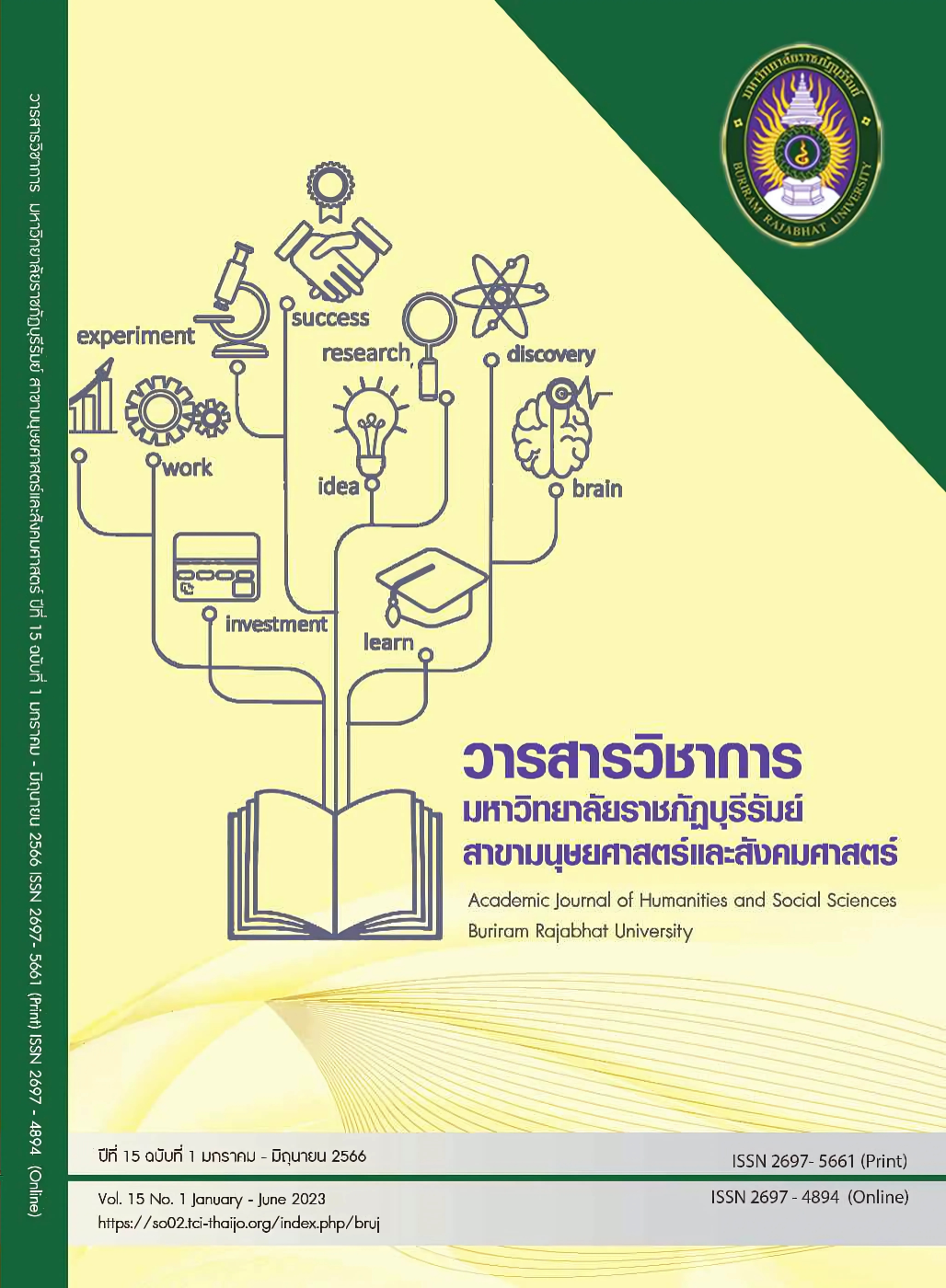พัฒนาการใหม่ของการอภิวิเคราะห์
Main Article Content
บทคัดย่อ
การอภิวิเคราะห์คือการวิจัยเชิงสังเคราะห์ผลการวิจัยปฐมภูมิจำนวนมากโดยวิธีการทางสถิติเพื่อให้ได้ผลการวิเคราะห์ที่มีความถูกต้องและน่าเชื่อถือมากกว่าผลการวิจัยปฐมภูมิแต่ละเรื่องจึงเป็นการวิจัยที่กำลังได้รับความสนใจมากขึ้น แต่ก็มีจุดด้อยบางอย่างที่ได้รับการวิจารณ์มากจึงได้รับการพัฒนาให้มีความก้าวหน้ามากขึ้นในหลายๆด้าน เช่น มีโปรแกรมสำเร็จรูปสำหรับการคำนวณที่ซับซ้อนจำนวนมาก มีสถิติสำหรับการตรวจสอบลักษณะต่างๆ ของข้อมูลเพิ่มขึ้นและมีวิธีวิจัยที่ก้าวหน้ามากยิ่งขึ้น เพื่อแก้ปัญหาเรื่องการวิเคราะห์ข้อมูลที่มีความหลากหลายมาก และให้ได้ผลการวิจัยหลายอย่างที่ก้าวหน้ากว่าเดิม เช่น Meta-Regression, Multilevel Meta-Analysis, Network Meta-Analysis และ Bayesian Meta-Analysis เป็นต้น
Article Details

อนุญาตภายใต้เงื่อนไข Creative Commons Attribution-NonCommercial-NoDerivatives 4.0 International License.
- ต้นฉบับที่ได้รับการตีพิมพ์ในวารสารวิชาการ มหาวิทยาลัยราชภัฏบุรีรัมย์ สาขามนุษยศาสตร์และสังคมศาสตร์ ถือเป็นกรรมสิทธิ์ของมหาวิทยาลัยราชภัฏบุรีรัมย์ ห้ามนำข้อความทั้งหมดหรือบางส่วนไปพิมพ์ซ้ำเว้นเสียแต่ว่าจะได้รับอนุญาตจากมหาวิทยาลัยฯ เป็นลายลักษณ์อักษร
- เนื้อหาต้นฉบับที่ปรากฏในวารสารเป็นความรับผิดชอบของผู้เขียน ทั้งนี้ไม่รวมความผิดพลาด อันเกิดจากเทคนิคการพิมพ์
เอกสารอ้างอิง
สุพัฒน์ สุกมลสันต์ (2535). การอภิวิเคราะห์และการสังเคราะห์งานวิจัยที่เกี่ยวข้องกับการเรียนการสอนภาษาอังกฤษระหว่างปี พ.ศ. 2515-2530. รายงานการวิจัย.
สถาบันภาษา จุฬาลงกรณ์มหาวิทยาลัย. Retrieved from http://cuir.car.chula.ac.th/xmlui/handle/123456789/783
อุทุมพร จามรมาน. การสังเคราะห์งานวิจัยเชิงปริมาณ. ภาควิชาวิจัยการศึกษา คณะครุศาสตร์. จุฬาลงกรณ์มหาวิทยาลัย.
Basu, A. (2017). How to conduct meta-analysis: A Basic Tutorial. Research Gate. Retrieved from https://www.researchgate.net/publication/345692348_How_to_conduct_meta-analysis_a_basic_tutorial
Bax, L. et al (2008). More Than Numbers: The Power of Graphs in Meta-Analysis. American Journal of Epidemiology, 169(2). Retrieved from https://academic.oup.com/aje/ article/169/2/249/96970.
Borenstein, M. et al (2007). Meta-Analysis Fixed Effect vs Random Effects. Retrieved from https://www.meta-analysis.com/downloads/M-a-f-e-v-r-e-sv.pdf.
Borenstein, M. et al (2009a). Meta-Regression. Retrieved from https://www.meta-analysis.com/downloads/Meta-analysis%20Meta%20regression.pdf
Borenstein, M. et al (2009b). Introduction to Meta-Analysis. Chapter 40: When does it make sense to perform a meta-analysis? John Wiley & Sons, Ltd. Retrieved from https://www.meta-analysis.com/downloads/when_does_it_make_sense_to_per form_a_meta-analysis.pdf.
Borenstein, M. et al (2017). I2 is not an absolute measure of heterogeneity in a meta-analysis. Biostat, Inc, Englewood, N.J., USA. Retrieved from https://www.meta-analysis-workshops.com/download/isquared.pdf.
Borenstein, M. et al (2020). Meta-Analysis Workshops. Retrieved from https://www.meta-analysis-workshops.com/download/common-mistakes2.pdf.
Bradburn, S. (2021). 13 Best Free Meta-Analysis Software to Use. TTB. Retrieved from https://toptipbio.com/free-meta-analysis-software/.
CMA. (2020). Comprehensive Meta-Analysis Program. Biostat, 14 North Dean Street, N.J., USA. Retrieved from https://www.meta-analysis.com.
Dillion, J.T. (1982). Superanaysis. American Journal of Evaluation, 3(4), 35-43.
Egger, M. et al (1997). Bias in meta-analysis detected by a simple graphical test. BMJ Vol. 315. Retrieved from https://www.bmj.com/content/315/7109/629.
Ferrer, R. (1998). Graphical methods for detecting bias in meta-analysis. ResearchGate. Retrieved from https://www.researchgate.net/publication/13513488_Graphical_methods_for_detecting_bias_in_meta-analysis.
Glass, G.V. (1976). Integrating Findings: The Meta-Analysis of Research. Journal of Education, 5(2).
Glass, G.V. et al (1981). Meta-Analysis in Social Research. Sage Publications, California.
Harrer, M. et al (2021). Doing Meta-Analysis with R: A Hands-on Guide. Boca Raton, Fl and London: Chapmann& Hall/CRC Press. ISBN 978-0-367-61007-4. Retrieved fromhttps://bookdown.org/MathiasHarrer/Doing_Meta_Analysis_in_R/.
Hedges, L. & Olkin, I. (1985). Statistical Methods for Meta-Analysis. Academic Press, Florida.
Higgin, J. & Green, S. (2011). Cochrane Handbook for Systematic Review of Interventions: Identifying and measuring heterogeneity. Retrieved from https://handbook-5-1.cochrane.org/.
Huedo-Medina, T. et al (2006). Assessing heterogeneity in meta-analysis: Q statistic or I2 index? CHIP Documents. 19. Retrieved from https://www.um.es/metaanalysis/pdf/5008.pdf.
Hunter, J. E. et al (1982). Meta-Analysis: Cumulating Research Findings Across Studies. The Academy of Management Review 9(1), January. Retrieved from https://www.researchgate.net/publication/275414777_Meta-Analysis_Cumulating_Research_Findings_Across_Studies.
Jackson, G.B. (1980). Methods for Integrative Review. Review of Educational Research, N. 3, Vol.50. Retrieved from https://www.jstor.org/stable/1170440.
Kulik, J. A. & Kulik, L. C. (1989). Meta-analysis in education. International Journal of Educational Research, 13(n3), 221-340.
Pathak, M. et al (2016). Which is the preferred measure of heterogeneity in meta-analysis and why? A Revisit. ResearchGate. Retrieved from https://www.researchgate.net/publication/315797816_Which_is_the_Preferred_Measure_of_Heterogeneity_in_Meta-Analysis_and_Why_A_Revisit.
Petitti, D. B. (2001). Approaches to heterogeneity in meta-analysis. Statistics in Medicine, 20. Retrieved from https://www.researchgate.net/publication/11611279_Approaches_to_heterogeneity_in_meta-analysis.
Pigott, T.D. (2012). Advances in Meta-Analysis. Springer Publisher.Springer: New York, Dordrecht Heidelberg, London.
Rafi, Z. (2018). Meta-Analysis: Choose Your Model Wisely. Retrieved from https://lesslikely. com/statistics/meta-analysis-models/.
Ried, K. (2018). Interpreting and understanding meta-analysis graphs: a practical guide. Australian Family Physician, 35 (8), August 2006. Retrieved from hdl_43554.pdf (Adelaide.edu.au).
Rothsteinm, H., Sutton, A. & Borenstein, M. (2005). Publication Bias in Meta-Analysis, Assessment and Adjustments. England: Chichester.
Salters-Pedneault, K. (2020). The Role of Meta-Analysis in Sciencetific Studies. Retrieve from https://www.verywellmind.com/definition-of-meta-analysis-425254.
SAS. (2016). UCLA: Statistical Consulting Group. Retrieved from https://stats.idre.ucla.edu/sas-learning-moduleintroduction-to-the-features-of-sas.
Schick-Makaroff, K. & MacDonal, M.A. (2016). What Systhesis Methodology Should I Use? A Review and Answer of Approaches to Research Synthesis. AIMS Public Health, April. Retrieved from https://www.ncbi.nlm.nih.gov/pmc/articles/PMC5690272.
Sedgwick, P. (2012). Meta-Analyses: tests of heterogeneity. Research Gate. Retrieved from https://www.researchgate.net/publication/271377859_Meta-analyses_tests_of_het erogeneity.
Spinelli, L. M. & Pandis, N. (2020). The importance of careful selection between fixed-effect and random-effects models. Retrieved from https://www.ajodo.org/article/S0889-5406(19)30970-9/fulltext.
SPSS 28. (2021). IBM SPSS Statistics Base 28. Retrieved from https://www.ibm.com/support/pages/downloading-ibm-spss-statistics-28010.
Sterne, J. C. et al. (2011). Recommendations for examining and interpreting funnel plot asymmetry in meta-analysis of randomized controlled trials. BMJ. Retrieved from https://www.bmj.com/content/343/bmj.d4002.
Sterne, J. C. & Harbord, R. (2004). Funnel Plots in Meta-analysis. Stata Journal, 4(2), 127-141. Retrieved from https://www.stata-journal.com/sjpdf.html?articlenum=st0061.
Townsend, Z. et al. (2013). The choice between fixed and random effects. Retrieved from http://agfda.userweb.mwn.de/ALD_2015/downloads/Uebung2/Townsend_et_al_2013.pdf.
Valentine, J. C. et al. (2013). How many studies do you need? A Prime on Statistical Power for Meta-Analysis. Sage Publications. Retrieved from https://journals.sagepub.com/doi/abs/10.3102/1076998609346961.


